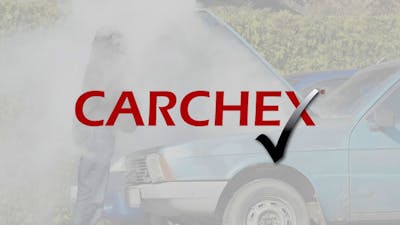How Do I Know When My Car Needs Brakes
Properly functioning brakes are critical to your safety and also your enjoyment of your vehicle. But how do you know when it's time to have your brakes serviced? It turns out there are a few ways to know when your car, truck, or SUV is ready for a brake job.
Popular Warranty Providers
Some Background on Brakes
In every modern vehicle, there is a brake system working on each corner. On almost all of them, the wear items are called pads and rotors. The rotors are the silver (sometimes rusty) discs you see when you look at a wheel through its spokes. The clamp you see is called the caliper. Inside the caliper on both sides of the rotor are brake pads. These are the basic components that make up each wheel.
Under your hood there is a master cylinder. This is the hydraulic pump that creates the added force needed to clamp down on the rotors via the calipers when you step on the brake. There is a small reservoir of brake fluid, usually located in the rear top of the engine bay, often on the right as you face it from the front, but not always. Metallic and rubber lines run the fluid where it needs to go under your car’s chassis.
On some odd models and older inexpensive models, vehicles may have what is called “drum brakes.” This type of brake system replaces the rotors with a drum, and the pads with what are called shoes. In this system, the frictional surfaces cannot be seen when you look at the assembly through your wheel spokes.
What is a “Brake Job?”
When you hear the term “brake job,” it usually means that a mechanic (or a technician, or a DIY car owner) will replace the brake rotors and shoes at one end of the car. Brakes are replaced in pairs. Although this is the crux of the job, a brake job done right also involves some inspections, some cleaning, and some lubrication. A brake job kit also comes complete with some small metallic clips and other hardware that the mechanic uses in the job. Auto parts stores and dealer parts counters often have the full bill of materials needed to perform a brake job already pulled together. Our image above shows a kit delivered by an auto supply warehouse to a shop.
Signs You May Need Brakes
If you hear a grinding, whistling, or high-pitched sound when you apply your brakes, the chances are you have worn your brake pads down to the point that it is time for a brake job. Brake pads are often designed to include an audible alert when they are worn past the point at which they should be serviced.
Sometimes the rotors of a car become warped due to improper use or a poor design by the manufacturer. When they warp, they no longer go around smoothly, and the pulse created is transmitted through the wheel or the seat, and a driver can feel it. Typically, it is the front rotors that warp. You likely have warped rotors if your steering wheel vibrates or shakes when you apply your brakes. This is not a dire emergency, but you should have the car inspected to see if you need a brake job.
If your vehicle has any loss in braking power or if they become "spongy" or “grabby,” have them inspected immediately. Never drive a vehicle that has a brake pedal that suddenly goes to the floor but then recovers some stopping power. It is a sign of a dangerous problem beyond just normal brake wear.
Can I Just Replace The Brake Pads and Keep the Old Rotors?
DIYers sometimes just replace the brake pads on their own vehicle. This is certainly possible, but no self-respecting mechanic would ever do this. There are many reasons why. First, the rotors wear by becoming grooved and also thinner. For safety, a brake rotor has a specification for its proper thickness. Too thin, and you may not have safe brakes.
The bigger reason is that if you put new pads on old rotors, the existing grooves on the rotor will cut the new pads. This reduces their effectiveness and shortens their life. Brake rotors are relatively inexpensive and worth a lot less than the time it takes to do a brake job all over again. New pads on old rotors can also cause warped rotors and noisy braking.
Back in the day of wooden ships and iron men, shops resurfaced brake rotors using lathes. Nearly every modern shop stopped doing so long ago. The cost to replace the rotors is lower, and the outcome is better with new rotors.
How Can I Be Sure If I Need Brakes?
The best way to know if you need brakes is to have them inspected. A mechanic will pull the wheels and then inspect the brakes visually. Brake calipers have a small window designed into them that allows the mechanic to see the pad thickness and measure it with a small tool. The measurement is in millimeters. The thickness is compared to your vehicle’s manufacturer’s specification to determine how much life is left.
That is not the end of a brake inspection. The mechanic will also hand-turn the tires when in neutral to see that the brakes are not dragging on the rotors. In addition, the mechanic looks at the brake rotors for signs of excessive grooves and any other indications of warping (such as heat discoloration). The parking brake should also be inspected, and the fluid should be checked for quantity and last change interval. Brake fluid has a lifespan.
How is Brake Life Determined By Your Mechanic?
If your brakes pass inspection, your mechanic will estimate the remaining brake life in either millimeters of brake pad remaining or a rough estimate of how many miles you can drive before changing them. For example, the mechanic might say, “4mm remaining, good till the next oil change.” What the mechanic means is that your brakes are fine and they can be inspected when you come back for your next oil change in 5,000 or 10,000 miles. Our top-of-page image shows a brake pad with the thickness explained.
Can I Look At My Brakes And Tell If They Need To Be Replaced?
It is not possible to be certain by looking that brakes are OK. However, there are some things you can look for to see if the brakes may be in need of service. If you look at all four of your wheels and one has black or reddish beige dust all over it (and the other three do not,) you likely have a frozen caliper. This means the caliper is not retracting and is grinding down the pad as you drive. Some rotor rusting and minor grooves on the surface are normal. A trained eye can tell if the rust indicates the caliper is not pinching or if grooves are so deep they indicate a pad that is no longer working properly. If you are in doubt, have a mechanic inspect the brakes. It is usually either free with an oil change or very inexpensive.
What If I Just Ignore My Brake Symptoms?
Although it is unwise, if you ignore your brake problem symptoms, you can expect them to get worse as time and miles pass. If you suspect brake issues, getting them fixed sooner may save you some money.
How Can I Properly Maintain My Brakes?
Brakes are maintenance-free. There are only two things you need to do. First, have them inspected at every oil change or at least every 15,000 miles. Second, follow your owner’s manual’s instructions regarding brake fluid changes. Changing brake fluid ensures that the lines and calipers don't suffer from corrosion and, in the long run, that water in the fluid does not cause problems when you are braking.
Who Can Repair My Brakes?
Any qualified mechanic can service your brakes. We suggest that you use either a trusted independent shop or the dealer for the best outcome. Chains can do the work, but the quality may not be the same. It is common in many larger shops for the least experienced person to do a lot of the brake work, hopefully under the supervision of an actual mechanic.
Can I Change My Own Brakes?
You certainly can change your own brakes. It is one of the DIY projects many people who are handy with tools like to do. However, we would never suggest that a person who has not previously been shown how to properly service brakes attempt it. Watch at least one brake service being performed. YouTube is helpful, but nothing beats having an experienced mechanic show you how to do a brake service. Here is a good example video of a mechanic doing a proper brake job. You will need some special tools to properly service brakes. These tools include a torque wrench.
How Much Does It Cost to Replace Brake Pads and Rotors?
It usually costs between $400 and $800 to replace the brake pads and rotors at one end of a vehicle. Want more details? Check out this focus story that does a deeper dive into brake repair costs.
Read more on Owning a Car here.













